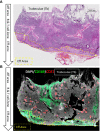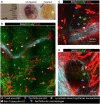The Internal Conduit System of the Swine Inverted Lymph Node
- PMID: 35734172
- PMCID: PMC9207403
- DOI: 10.3389/fimmu.2022.869384
The Internal Conduit System of the Swine Inverted Lymph Node
Abstract
Lymph nodes (LN) are the crossroad where naïve lymphocytes, peripheral antigens and antigen presenting cells contact together in order to mount an adaptive immune response. For this purpose, LN are highly organized convergent hubs of blood and lymphatic vessels that, in the case of B lymphocytes, lead to the B cell follicles. Herein take place the selection and maturation of B cell clones producing high affinity antibodies directed against various antigens. Whereas the knowledge on the murine and human LN distribution systems have reached an exquisite precision those last years, the organization of the antigens and cells circulation into the inverted porcine LN remains poorly described. Using up to date microscopy tools, we described the complex interconnections between afferent lymphatics and blood vessels, perifollicular macrophages, follicular B cells and efferent blood vessels. We observed that afferent lymphatic sinuses presented an asymmetric Lyve-1 expression similar to the one observed in murine LN, whereas specialized perifollicular sinuses connect the main afferent lymphatic sinus to the B cell follicles. Finally, whereas it was long though that mature B cells egress from the inverted LN in the T cell zone through HEV, our observations are in agreement with mature B cells accessing the efferent blood circulation in the efferent, subcapsular area. This understanding of the inverted porcine LN circuitry will allow a more accurate exploration of swine pathogens interactions with the immune cells inside the LN structures. Moreover, the mix between similarities and differences of porcine inverted LN circuitry with mouse and human normal LN shall enable to better apprehend the functions and malfunctions of normal LN from a new perspective.
Keywords: B lymphocytes; endothelial cell (EC); fluorescence imaging (FLI); follicle; lymph node (LN); second harmonic generation (SHG); swine (source: MeSH NLM); whole organ imaging.
Copyright © 2022 Dubreil, Ledevin, Hervet, Menard, Philippe, Michel, Larcher, Meurens and Bertho.
Conflict of interest statement
The authors declare that the research was conducted in the absence of any commercial or financial relationships that could be construed as a potential conflict of interest.
Figures







Similar articles
-
Macrophage-B Cell Interactions in the Inverted Porcine Lymph Node and Their Response to Porcine Reproductive and Respiratory Syndrome Virus.Front Immunol. 2019 May 3;10:953. doi: 10.3389/fimmu.2019.00953. eCollection 2019. Front Immunol. 2019. PMID: 31130951 Free PMC article.
-
Halted Lymphocyte Egress via Efferent Lymph Contributes to Lymph Node Hypertrophy During Hypercholesterolemia.Front Immunol. 2019 Mar 27;10:575. doi: 10.3389/fimmu.2019.00575. eCollection 2019. Front Immunol. 2019. PMID: 30972070 Free PMC article.
-
Gene-expression profiling of different arms of lymphatic vasculature identifies candidates for manipulation of cell traffic.Proc Natl Acad Sci U S A. 2016 Sep 20;113(38):10643-8. doi: 10.1073/pnas.1602357113. Epub 2016 Sep 6. Proc Natl Acad Sci U S A. 2016. PMID: 27601677 Free PMC article.
-
Structure and function of rat lymph nodes.Arch Histol Cytol. 2008 Sep;71(2):69-76. doi: 10.1679/aohc.71.69. Arch Histol Cytol. 2008. PMID: 18974599 Review.
-
Lymph node lymphatic endothelial cells as multifaceted gatekeepers in the immune system.Trends Immunol. 2023 Jan;44(1):72-86. doi: 10.1016/j.it.2022.10.010. Epub 2022 Nov 30. Trends Immunol. 2023. PMID: 36463086 Review.
Cited by
-
Effect of mucosal adjuvant IL-1β on heterotypic immunity in a pig influenza model.Front Immunol. 2023 Apr 20;14:1181716. doi: 10.3389/fimmu.2023.1181716. eCollection 2023. Front Immunol. 2023. PMID: 37153548 Free PMC article.
-
Porcine Macrophage Markers and Populations: An Update.Cells. 2023 Aug 19;12(16):2103. doi: 10.3390/cells12162103. Cells. 2023. PMID: 37626913 Free PMC article. Review.
-
Bright-Field Multiplex Immunohistochemistry in Swine PCV2 and PRRSV Lymphadenopathies.Animals (Basel). 2025 Jun 6;15(12):1682. doi: 10.3390/ani15121682. Animals (Basel). 2025. PMID: 40564235 Free PMC article.
References
Publication types
MeSH terms
LinkOut - more resources
Full Text Sources
Miscellaneous

